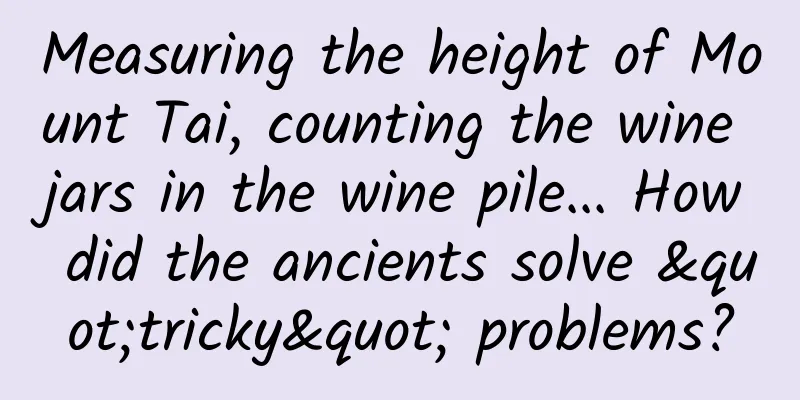Measuring the height of Mount Tai, counting the wine jars in the wine pile... How did the ancients solve "tricky" problems?

|
Measuring the height of Mount Tai, calculating the number of wine jars in a wine pile, and finding the volume of irregular objects... How did the ancients solve these problems thousands of years ago? Come to the exhibition at the China Science and Technology Museum to find the answers. Recently, the China Science and Technology Museum launched the "Different Places, Common Achievements in Mathematics, the Founding of Civilization" exhibition to celebrate the 1800th anniversary of Liu Hui's birth. The exhibition introduced the important achievements of ancient Chinese mathematics from the perspective of the development of human civilization and the integration and mutual learning of Chinese and Western cultures, and many interactive devices were also set up on site. "This exhibition is a combination of science, culture and art. We have made large passages of text in ancient books visual, touchable and interactive. We hope that through this exhibition, young people can discover the fun of mathematics, approach mathematics and fall in love with mathematics." said Pan Ximing, deputy director of the Exhibition Design Center of the China Science and Technology Museum. Calculate two-digit multiplication using small wooden sticks In ancient times, mathematics played an important role in agricultural production, and the ruling class also regarded it as an important skill. It is possible that as early as the Zhou Dynasty, noble children had already begun to use counting rods for calculation. Counting sticks, which look like small wooden sticks or bamboo sticks, are tools used by ancient people to count, list and perform calculations. How are these small wooden sticks used for calculations? On the interactive device of counting sticks in the exhibition hall, visitors input the multiplication of two-digit numbers, and the calculation process of the counting sticks will be displayed on the screen. The counting sticks follow the decimal system and represent 1-9 in two ways: vertically and horizontally. When representing two-digit numbers, the ones place is in vertical form and the tens place is in horizontal form. If there is a zero, leave it blank. For complex multiplication, the counting sticks are arranged in three rows, with the middle row being the product, the bottom row being the multiplier, and the top row being the multiplicand. The result can be obtained by combining the Nine Nine Formulas with the counting method of counting sticks. The process is similar to modern vertical multiplication. The ancients not only used counting rods for addition, subtraction, multiplication and division, but also for complex calculations such as square roots and quadratic equations to solve practical problems such as land reclamation and grain replacement. Following Liu Hui to measure the height of Mount Tai During the Wei and Jin Dynasties, mathematics experienced a great development. Liu Hui during this period played an important role in the history of Chinese mathematics and was the main founder of Chinese classical mathematical theory. He annotated the ancient Chinese mathematical classic "Nine Chapters on the Mathematical Art" and established the theoretical foundation for Chinese classical mathematics for the first time. In particular, Liu Hui made many groundbreaking achievements, such as the method of dividing a circle, the method of square and cover, and the method of weight difference. At the exhibition, visitors can see the proof process of Liu Hui's circle-cutting method: starting from a regular hexagon inscribed in a circle, the number of sides doubles each time, and the circle is continuously approximated by regular polygons. When the regular 96-gon polygon is calculated, the value of π is 3.14. After that, Liu Hui calculated the regular 3072-gon polygon and obtained a more accurate value of 3.14159. By carefully observing the Mouhe square model in the exhibition hall, the audience can understand Liu Hui's idea of using the infinite division method to calculate the volume of the cube, and marvel at his keen observation and imagination. Liu Hui applied the method of weight difference to measure the height of islands, and through analogy, developed it into a complete set of theories for measuring height, depth, width and distance, that is, using a ruler to repeatedly measure from different positions, and calculating the difference points obtained, so as to find the height of the mountain or the depth of the valley. Liu Hui wrote it into "Sea Island Mathematical Classic", and the original of this work was displayed at the exhibition site, allowing the audience to have a glimpse of the style of the ancient mathematical classics. The number of wine jars can be calculated using an arithmetic progression The political enlightenment during the Song and Yuan dynasties promoted the development of agriculture and commerce, and handicrafts also flourished, with the wine industry being one of the most representative. The mountains of wine jars were countless and troubled the merchants at that time. In order to solve this problem, Shen Kuo, a scientist in the Northern Song Dynasty, first invented the stacking method. Yang Hui in the Southern Song Dynasty and Zhu Shijie in the Yuan Dynasty successively improved and developed it, which can quickly and accurately calculate the number of wine jars. This method is also often used to calculate the number of stacked grains, goods, etc. This also indicates that the ancients had done some research on the sum of high-order arithmetic progressions. In the exhibition hall, the "Geometry of Wine Jars" exhibit vividly demonstrates the application of the stacking technique. The audience puts the wine jar models arranged at different heights into the sensing area, and the electronic screen quickly displays the number of wine jars on each layer, and uses the arithmetic sequence summation formula to clearly list the calculation process and the total number of wine jars. After the demonstration, the audience couldn't help but exclaim in admiration of the wisdom of the ancients. Light up the Pythagorean tree by blowing on it The Pythagorean theorem is an important theorem that connects "number" and "shape". In China, Shang Gao, a mathematician in the Western Zhou Dynasty, proposed "the hypotenuse is three, the leg is four, and the chord is five", which proved the Pythagorean theorem concisely and clearly. Later, Euclid in the West, Zhao Shuang and Liu Hui in China proved the Pythagorean theorem using different methods. "According to incomplete statistics, there are about 500 proof methods in the world. We have concretized some of these methods in the exhibition hall." Pan Ximing pointed to the Pythagorean tree and introduced it to reporters. The Pythagorean tree, also known as the "Pythagorean tree", is a tree-shaped figure that can be repeated infinitely based on the Pythagorean theorem. In the exhibition hall, visitors blow into the instrument, and the light moves rapidly along the squares and triangles, lighting up the Pythagorean tree on the wall. In the process, visitors can also have a deeper understanding of the Pythagorean theorem. As you watch and experience the exhibition, after a round, you will exclaim, "It turns out that mathematics is all around us!" In fact, mathematics is not profound, it is very beautiful. (Science Popularization Times intern reporter Wang Wenjie) |
<<: Cells are like "series circuits"! It is the "electrical monster" in the Amazon water
>>: Can ordinary people diagnose depression, mania, and bipolar disorder on their own?
Recommend
China Passenger Car Association: China imported 56,000 vehicles in January-February 2025, a year-on-year decrease of 46%.
Cui Dongshu, secretary general of the China Passe...
What to do when SEM bidding promotion encounters negative SEO news?
What to do when SEM bidding promotion encounters ...
World's first! Hangzhou Asian Games "robot dog" throws discus, cute and high-tech!
"Look! There's a puppy on the field"...
Gaoyun Contract: Civil Code Edition "Enterprise High-Frequency Contract Writing, Review and Revision Series" Value 299 yuan - Baidu Cloud Download
This set of courses comes from Gaoyun Contract: &...
If Apple Watch became like this, would you buy it?
The launch date of Apple Watch has been delayed a...
What kind of magical existence is the “irritating food” that we have heard about since childhood?
"Mutton is fat, don't eat it" "...
APP promotion and operation: 10 cases tell you how to acquire users through users
I give the following definition of user operation...
Using RenderScript to achieve Gaussian blur (frosted glass/frosted) effect
Preface When browsing Instagram, I accidentally d...
U.S. sales fell in the first four months, and automakers will stop production and reduce inventory
According to foreign media reports, American auto...
Compared to Jobs, Apple under Cook is more and more prone to delaying its delivery
The touch and shock that Jobs brought to us are i...
A timely help? NIO completes $100 million convertible bond financing
Recently, NIO announced that it has signed a conv...
New energy vehicles make money by selling credits to make up for the vacancy caused by the reduction of subsidies?
At present, the financial subsidies for new energ...
Carrying the weight forward: the magical function of exoskeleton equipment
A normal adult has 206 bones in his body, and our...
National Memorial Day丨We will never forget the grief of our country!
84 years ago today Japanese invaders capture Nanj...









